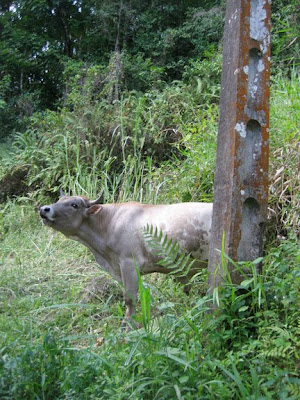



We do find a funky old hotel for the evening, just south of St. Pierre. Before the 1902 debacle, St. Pierre was the bustling capitol city with a sophisticated European bent. Most of the city was lost and not re-built when the bulk of the remaining population moved safely southward to Fort de France, but there is still a very Euro flair to the area, giving it a different feel from other island towns. Our hotel is the perfect example - tucked into the shade of a northern hillside and towering trees, its massive stuccoed walls, single-room width with 18' ceilings and 12' solid wood doors located opposite one another for simple cross-ventilation keep the building quite cool. There is fabulous original tile, and a giant (unused) bathtub, and some updates -- like a slightly more contemporary outdoor kitchen in the garden where one can "take their cafe" in the morning. There are, of course other updates - like AC units, and throwbacks - roaches that surely claim pre-Peléan heritage.
St. Pierre is a good-sized town with, what seems the requisite two one-way mainstreets running parallel to the beach. As with much of the island, houses and townhouses are quite compact. Due to the terrain, it's fairly common to have both beach- and volcano views. Although nearly all of the buildings remain shuttered against the sun - with, perhaps, 60% actually seeming to be occupied. There could be a higher number of abandoned buildings in St. Pierre compared to elsewhere, but it's difficult to tell.















































